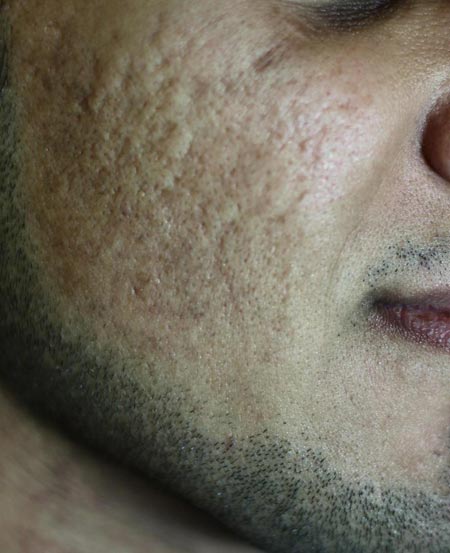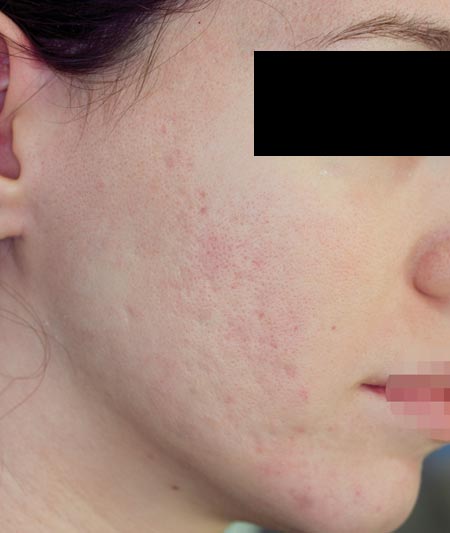Our skin can be scarred in numerous ways including burns, accidents, acne, surgery or chicken pox. Scars are often physically unsightly and psychologically may cause considerable emotional distress.
In response to injury, the deeper layers of the skin (dermis) immediately begin repairing the damaged area. Specialist cells migrate into the wound. macrophages remove debris and dead cells whilst fibroblasts manufacture collagen that ‘bridges the gap’ over the damaged area to seal the injured skin.
As damaged skin may take up to 18 months to reach cosmetically acceptable mature healing, it is important to have scars assessed by a doctor who may recommend an early intervention if indicated or a ‘wait and see’ approach.

Before

After

Before

After
Scars can be classified according to colour or texture:
Red Scars or Post Inflammatory Erythema (PIE) – More common in lighter skin types – most scars will be red during the initial healing process and usually unwanted redness will fade over time. However, in some cases, redness may persist as a result of increased vascularity or transparency. Optimal treatment for the removal of unwanted redness utilises the V Beam 595nm PDL laser.
Brown scars or Post Inflammatory Hyperpigmentation (PIH) – more common in darker skin types – caused due to excessive melanin accumulating within the scar and usually transient. If the discolouration persists beyond 9 months, treatment with Q switched Ruby 694nm / KTP 532nm or Nd Yag 1064nm lasers can help to fade the unwanted pigmentation.
Ice Pick Scars – These are deep narrow scars that make the skin appear as if it has been punctured with an ice pick – Optimal treatment is TCA Cross – droplets of 100% TCA are placed into the scar, promoting the migration of fibroblasts into the damaged area stimulating new collagen production.
Boxcar Scars – These scars are sunken and round in appearance, similar to a chicken pox scar – optimal treatment includes Er Yag 2940nm and CO2 10,600nm lasers in both traditional and fractional modes. (Described in detail in the Skin Resurfacing section of this website)
Rolling Scars – These scars occur as a result of tethering of otherwise normal looking skin, resulting in an undulating surface appearance – optimal treatment includes Er Yag 2940nm and CO2 10,600nm lasers in both traditional and fractional modes. (Described in detail in the Skin Resurfacing section of this website)
Atrophic Scars – Result in large indented sunken areas of scarring with a loss of volume – optimal treatment involves fat grafting or dermal fillers.
Tethered or Anchored scars – occur when the top layers of the skin become stuck down to the muscle – identified by puckering of the scar during muscle contraction – optimal treatment is surgical subcision.
Hypertrophic scars and Keloid scars – occur when the body overproduces collagen at the wound site, causing the scar to be raised above the surrounding skin – optimal treatment methods include silicone gel sheets or similar long chain polymers, steroid injections freezing of the scar with liquid nitrogen, or surgery.
It is rare for a patient with scarring to present with just one type of scar as usually several scar types coexist at the same time and hence multiple treatment modalities are required concurrently for optimal results. A detailed medical consultation is mandatory with examination under angled lighting key to ensure the correct diagnosis of scar type is made. Our Cambridge Laser Clinic offers the full range of treatment options ensuring superior results.
Our expert medical team has in excess of 30 years laser experience and have completed more than 150,000 successful treatments. Rest assured you are in safe hands. All procedures at our Cambridge Laser Clinic are performed by fully qualified doctors, nurses and practitioners.
To ensure the highest ethical standards are maintained at all times, our staff are never offered bonus incentives to sell treatments.
Although medical laser clinics are no longer regulated by the CQC (Care Quality Commission), we continue to adhere to the strict standards that were in the past mandatory under government legislation. This is the best indicator currently available that our Cambridge Laser Clinic is trustworthy.
All consultations are free of charge so why not call our team of experts today?
